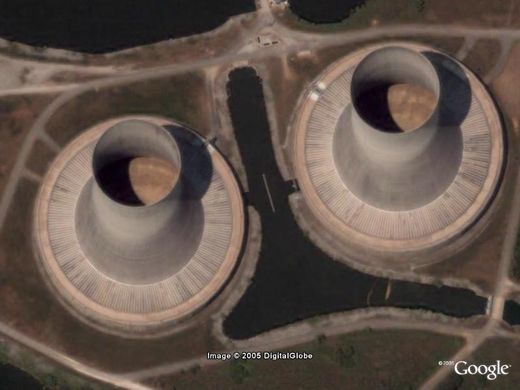
Sequoyah Nuclear Plant in Chattanooga, Tennessee, USA, as seen from space
Progress Energy's chief nuclear officer announced this week that
every U.S. nuclear plant will add an extra layer of emergency equipment this year to deal with unforeseen natural disasters - such as earthquakes, tornadoes and even meteor strikes.
The announcement comes just ahead of the one-year anniversary of Japan's Fukushima disaster.
But nuclear watchdogs immediately expressed skepticism that the industry effort would do much good. Critics warned instead that unless the new machinery and equipment were safeguarded, the costly upgrades would likely be disabled by the same catastrophe if it obliterated a nuclear plant's primary emergency equipment.
Jim Scarola, Progress Energy's chief nuclear officer, said Friday that nuclear plants in this country will be adding pumps, generators and other safety equipment to deal with a total loss of onsite power, which led to Japan's nuclear crisis.
Scarola is the special liaison for the U.S. nuclear industry's Fukushima response, which was set up to improve nuclear plant safety in the past year. The U.S. effort was formed just a day after a 50-foot tsunami disabled coastal reactors in Japan on March 11, 2011, washing away diesel generators and other emergency equipment, and claiming 19,000 lives by drowning in the inundated region.
"One of the things we set out to do is not to take the stance that it can't happen here," Scarola said of the nation's nuclear officials. "What we're really concerned about is being able to provide water and energy" to keep safety equipment running during a catastrophic event that causes high death rates and wipes out roads and other infrastructure.
Efforts criticizedElectric utilities are upgrading the 104 commercial operating nuclear reactors in this country in anticipation of stricter federal rules. The U.S. Nuclear Regulatory Commission is expected to issue its first round of recommendations next week to make the reactors safer during earthquakes, flooding and other disasters.
But in a report issued this week, the Union of Concerned Scientists, a 43-year-old nuclear watchdog organization, criticized the industry effort as misguided.
"Plant owners are dispersing (extra equipment) in numerous locations on and near reactor sites but are not planning to harden it against natural disasters," the group said. "The industry is banking on there being enough equipment available so that at least some of it would be usable in the event of a catastrophe."
Getting ahead of NRCFurthermore, the group chided the NRC for taking so long to create tougher standards.
"The industry has already purchased more than 300 pieces of ... equipment without waiting for NRC guidelines, which will make it difficult for the agency to later institute standards that could force the industry to replace the equipment," the scientist organization said.
Chief nuclear officers at U.S. nuclear plants agreed three weeks ago to purchase the extra equipment, Scarola said. The cooling systems would override disabled pumps to prevent the reactor fuel from overheating, melting down and releasing radioactivity into the atmosphere.
Raleigh-based Progress Energy has already ordered the equipment for its four nuclear plants in the Carolinas and Florida, he said. This first phase of upgrades will cost each nuclear plant between $500,000 and $1.5 million for portable pumps, generators, lights, fans, direct-current supplies, satellite phones and other equipment.
The equipment would be just the beginning of upgrades that could take several years to implement, however.
Regional centersScarola also said Friday that the nuclear industry is developing regional response centers that could airlift emergency equipment, fuel and water to operate emergency cooling equipment in the event that a nuclear plant is severely disabled by a meteor or some other catastrophe.
Industry officials are looking at creating anywhere from one to five such response centers around the country that would support nuclear plants indefinitely in the event that roads as well as phone links were wiped out.
Nuclear plants typically have a seven-day capacity to operate emergency cooling pumps with backup generators, with the assumption that roads would be passable so that more fuel could be trucked in.
The NRC will issue its recommendations in three phases in the coming years. Other changes the NRC could consider - which have been proposed by the UCS and as recently as this week by the American Nuclear Society - would expand the 10-mile emergency evacuation zones around each reactor to account for large population centers nearby.
The Shearon Harris evacuation zone includes about 122,000 people, mostly in Wake County. The Harris plant's evacuation plan doesn't include contingencies for Raleigh, a city of more than 400,000 residents, which sits just outside the evacuation zone.
Coastal erosion has been around for millions of years. Building a nuclear site in a place where erosion occurs is just stupid, this is just a statement to make the paying of decommissioning more palatable to the sheeple taxpayers, especially as the nuclear sites are privately owned.